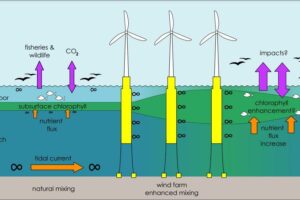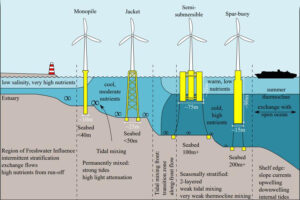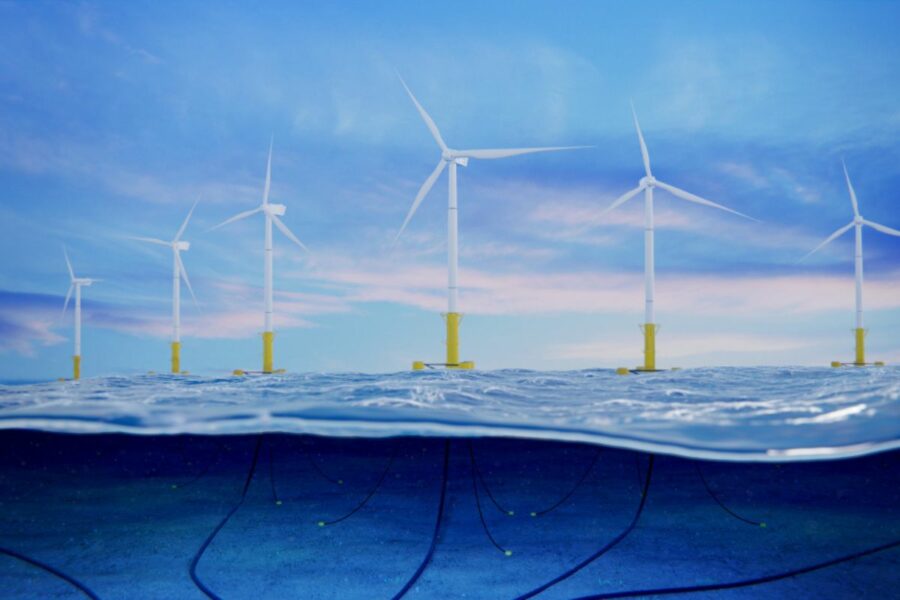Floating wind farms are seen as the next big thing in the renewable energy industry as they can be installed further from shore where the winds are stronger – but oceanographers from Bangor University are calling for new research into the environmental impact of turbulence caused by tidal flow past floating deepwater wind farms and shelf-sea ecosystems.

The flow past deepwater wind farms will introduce additional turbulence, and increase mixing – a fundamental change that could lead to significant impacts on marine life. (Graphics: Bangor University)
The UK is already among the world-leading countries when it comes to installed capacity – currently around 10GW – and earlier this year it increased its target for offshore wind to 50GW by 2030. Of this, 5GW will be floating wind. Previously, the UK had a goal of building 40GW by 2030, of which 1GW would have been floating wind.
The Bangor University researchers said: “New floating offshore wind turbines in the deep shelf seas have been identified as a major pathway toward achieving net zero for the UK. The technology involved has extended growth targets – the current target to produce 50GW by 2030 is an increase of 67% on the target set just 12 months ago.
“But with an additional 20,000 wind turbines set to be built, we need to ensure that we’re fully aware of the positive and negative effects their presence could have on the surrounding environment.”
Most of the world’s wind farms are located in shallow waters near the shore. However, new offshore sites at a depth of over 50m are very different in nature to the shallow coastal sites that have been used so far, say the researchers.
Dr Ben Lincoln of Bangor University explained: “Our shelf seas are fully mixed during winter, but during summer months the deeper regions stratify, with a warm surface layer overlying the cooler water below.
“This triggers a phytoplankton bloom which can be seen from space and forms the base of the marine food chain, supporting fish, seabirds and whales. During the summer months following the spring bloom, phytoplankton growth is supported by nutrients stirred up from below by turbulence associated with wind and tides.
“This turbulence also mixes oxygen down to the deep water, where it is required for other key biological processes.”
New research is therefore needed to fully understand how siting varying types of wind turbines could affect not only the seabed, but the waters and everything they contain, he said.

Existing and emerging offshore wind designs, including fixed monopile and jacket foundations in shallow water, and the floating semi-submersible and spar-buoy foundations planned for use in future deepwater developments.
“Environmental assessments for the shallow shelf seas have focused on wildlife using or living within the affected areas. The difference with the deeper seas is that the fundamental functioning of the seas themselves could be affected,” explained Dr Lincoln.
“Turbulent mixing determines the timing and rate of the food supply on which the marine ecosystem and key species rely. Flow past deepwater wind farms will introduce ‘anthropogenic’ or man-made turbulence, and increase mixing. This fundamental change could lead to significant regional impacts, which must be assessed.
“However, impacts are not necessarily negative, with the potential to enhance productivity and offset the impact of increasing stratification due to climate change.
“There’s no doubt that this growth in renewable energy is essential to meet global 2050 net zero commitments. However, we urgently need a deeper understanding of the dynamics involved in placing offshore wind farms, from a single unit to large arrays, and how that will affect the functioning of our shelf sea ecosystems.
“This understanding will help guide the planning of new wind farms to ensure they have a positive impact on the ecosystem.”
This story was taken from the latest issue of Fishing News. For more up-to-date and in-depth reports on the UK and Irish commercial fishing sector, subscribe to Fishing News here or buy the latest single issue for just £3.30 here.








